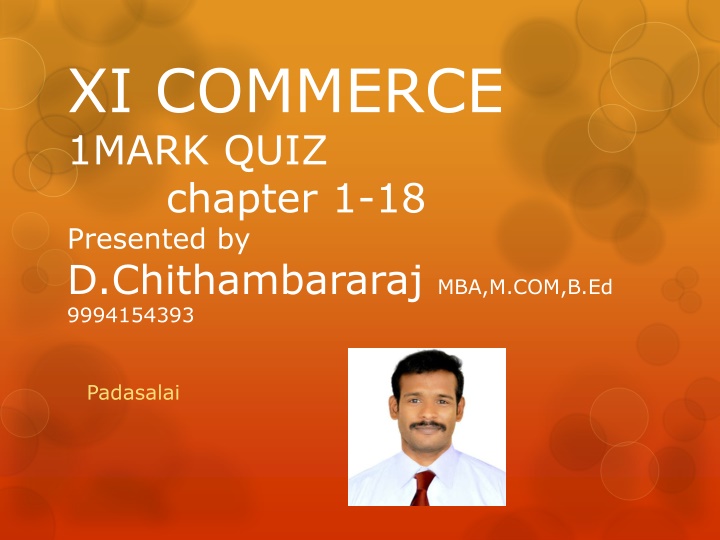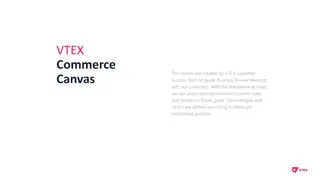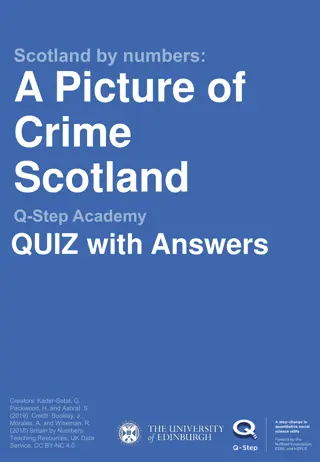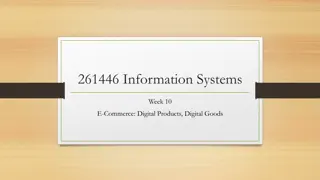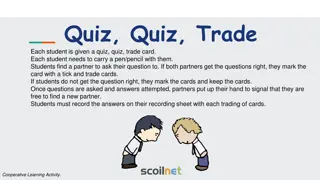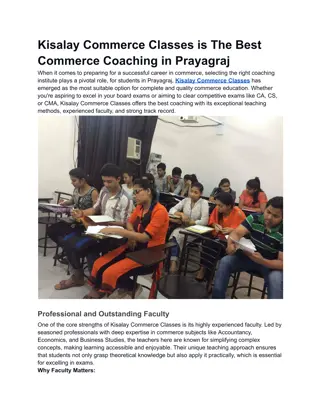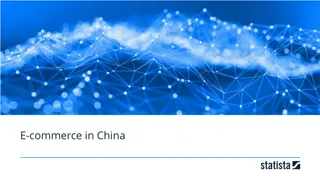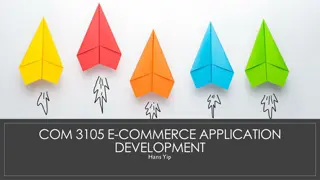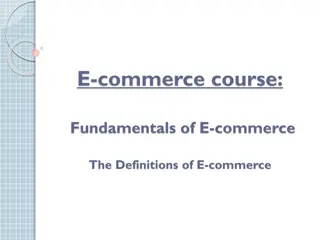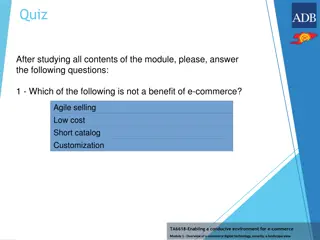XI Commerce 1-Mark Quiz - Chapter 1-18 Overview
This quiz covers topics such as the place where goods are sold, hindrances in trade, historical figures like Kautilya, dynasties involved in trade, and the primary objectives of businesses. Explore various aspects of commerce from ancient to modern times through these multiple-choice questions.
Download Presentation

Please find below an Image/Link to download the presentation.
The content on the website is provided AS IS for your information and personal use only. It may not be sold, licensed, or shared on other websites without obtaining consent from the author.If you encounter any issues during the download, it is possible that the publisher has removed the file from their server.
You are allowed to download the files provided on this website for personal or commercial use, subject to the condition that they are used lawfully. All files are the property of their respective owners.
The content on the website is provided AS IS for your information and personal use only. It may not be sold, licensed, or shared on other websites without obtaining consent from the author.
E N D
Presentation Transcript
XI COMMERCE 1MARK QUIZ chapter 1-18 Presented by D.Chithambararaj MBA,M.COM,B.Ed 9994154393 Padasalai
1.The place where the goods are sold is ______________ (a)Angadi (b) Market (c) Nalangadi (d) Allangadi
2.Hindrance of place is removed by _____________ (a) Transport (b) Warehouse (c) Salesman (d) Insurance
3.Who wrote "Arthasasthra"? (a) Kautilya (c) Thiruvalluvar (d) Elangovadigal (b) Chanakiya
4.Trade and Commerce was common to ____________ Dynasty. (a) Pallava (b) Chola (c) Pandiya (d) Chera
5._____________ was first sultan who paved way in the dense forest and helped traders to move from one market place to others place for their commercial caravans. (a) Balban (b) Vascoda Gama (c) Akbar (d) Alauddin Khilij
6.The Primary objective of a business is (a) Making Profit (b) Not making Profit (c) Special Skill (d) None of the above
7.Occupation of a Doctor is (a) Employment (b) Business (c) Profession (d) Sole Proprietor
8.The following does not characterize business activity? (a) Production of goods and services (b) Presence of risk (c) Sale or exchange of goods and services (d) Salary or wages
9.Activities undertaken out of love and affection or with social service motive are termed as : (a) Economic activities (b) Monetary activities (c) Non-Economic activities (d) Financial Activities
10.The industries engaged in extraction of iron ore are known as (a) Construction Industries (b) Manufacturing Industries (c) Extraction Industries (d) Genetic Industries
11.Auxiliaries to trade is also called as (a) Trade (b) Advertisement (c) Warehousing (d) Aids to Trade
12.Production which involves several stages for manufacturing finished product is known as (a) Analytical Industry (b) Synthetic Industry (c) Processing Industry (d) None of the above
13.Normally high level risk involved in (a) Industry (b) Commerce (c) Trade (d) All of the above
14.Commerce is mainly concerned with (a) Connecting producer and consumer (b) Pricing of goods (c) Buying and Selling of goods (d) Manufacturing of goods
15.Which is the oldest form of Business organisation? (a) Sole Proprietorship (b) Partnership (c) Co-operative Society (d) Company
16.In which form the owner, establisher and manager is only one? (a) Joint Enterprise (b) Government Company (c) Co-operative Society (d) Sole Proprietor
17.A major disadvantage of sole proprietorship is __________. (a) Limited liability (b) Unlimited liability (c) Easy Formation (d) Quick decision
18.From the following which one is Non-corporate form of business? (a) Joint stock company (b) Sole trading business (c) Government company (d) Co-operatives
19.The firm of Hindu Undivided Family is managed by whom? (a) Owner (b) Karta (c) Manager (d) Partner
20.In the firm of Hindu Undivided Family, how one gets the membership? (a) By Agreement (b) By Birth (c) By Investing Capital (d) By Managing
21.The Members in the joint Hindu family are called ________ (a) Karta (b) Coparceners (c) Generations (d) Partners
22.Only the male members in the family get the right of inheritance by birth' as ________ (a) Hindu law (b) Mitakshara Law (c) Dayabhaga law (d) None of these
23.A partnership is formed by ___________ (a) agreement (b) relationship among persons (c) the direction of government (d) friendship
24.Registration of partnership is _________ (a) compulsory (b) optional (c) not necessary (d) none of the above
25.A temporary partnership which is formed to complete a specific job doing a specified period of time is called ____________ (a) Partnership-at-will (b) Particular partnership (c) Limited Partnership (d) Joint Venture
26.The partnership deed also called _____________ (a) Articles of Association (b) Articles of Partnership (c) Partnership Act (d) Partnership
27.A partnership is registered with __________ (a) Registrar of Companies (b) Registrar of Co-operatives (c) Registrar of Firms (d) District Collector
28.The relationship between outsiders and the company is defined in ___________ (a) Prospectus (b) Articles of Association (c) Memorandum of Association (d) Certificate of Incorporation
29.Table A of the Companies Act is a __________ (a) Model minutes book (b) Model form of Balance Sheet (c) Model of AOA (d) Model of MOA
30.Which of the following is created by a Special Act of Parliament or in State Assemblies? (a) Chartered company (b) Foreign company (c) Government company (d) Statutory company
31.The Board of directors of a company is elected by _________ (a) Creditors (b) Debtors (c) Debenture holders (d) Share holders (members)
32.Companies established as a result of a charter granted by the King or Queen of a country is called ____________ (a) Chartered companies (b) Statutory companies (c) Registered companies (d) Foreign companies
33.Membership in a Co-operative organization is : (a) Not open to all (b) Selective (c) Open to all (d) None of them
34.Co-operative fails because of------------ (a) Unlimited membership (b) Cash trading (c) Mismanagement (d) Loss-making
35.All Co-operatives are established with (a) Philanthropic motive (b) Service Motive (c) Profit motive (d) Reform motive
36.Consumers Co-operation was first successful in--------- (a) England (c) Swiss (b) USA (d) India
37.Rochdale Society of equitable pioneers was started by-------------- (a) Robert Owen (b) H.C. Calvert (c) Talmaki (d) Lambert
38.A Multinational Corporation can be defined as a firm which (a) is beyond the control of any government (b) is one of the top 200 firms in the world (c) owns companies in more than one country (d) All the above
39.Centralised control in MNC's implies control exercised by (a) Branches (b) Subsidiaries (c) Headquarters (d) Parliament
40.Enterprises operating in several countries but managed from one country is termed as ---------- (a) Government company (b) Multinational company (c) Private company (d) Joint Venture
41.Dispersal of decision making power to branches/ affiliates/subsidiaries by head office represent ------ (a) Centralisation (b) Decentralisation (c) Power (d) Integration
42.Coca-Cola company is an example of ---------- (a) MNC (b) Government company (c) Joint Venture (d) Public company
43.The share capital of the government company must not be less than (a) 49% (b) 51% (c) 50% (d) 25%
44.Airport Authority of India is a public enterprise.Identify the form of organisation (a) Statutory Corporations (b) Departmental Undertakings (c) Multi-National Corporations (d) State Owned Company
45.The oldest form of organisation in public sector (a) Public Sector Undertakings (b) Departmental Undertakings (c) Multi-National Corporations (d) Statutory Corporation
46.A Government company purchases shares in the name of (a) Prime Minister (b) President (c) Chief Justice of India (d) State Chief Minister
47.The primary objective of the state enterprises is to ---------- (a) Earn profit (b) Provide Employment (c) Serve the People (d) All the Above
48.Which bank has the power to issue Bank notes? (a) Central Bank (b) Commercial Bank (c) Co-operative Bank (d) Foreign Bank
49.The Central Bank of India is (a) PNB (b) SBI (c) IClCI (d) RBI
